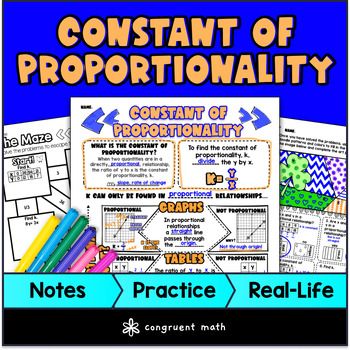Want more ideas and freebies?
Get my free resource library with digital & print activities—plus tips over email.
Join for Free Resources →
$4.25
Ever wonder how to teach constant of proportionality to your students? Looking for ideas to make it relevant to your students' life?
Use this artistic, real-life lesson plan to teach your students about the constant of proportionality and how to find k from graphs, equations, and tables.
Students will learn how constant of proportionality explains why their cell phone charger gets so hot, and why different devices take different amounts of time to charge. This lesson plan introduces the topic with guided notes (like sketch notes), practices the topic with a doodle & color by number worksheet and a maze activity, and wraps up with the real life application of constant of proportionality for cell phone chargers.

$4.25
After this lesson, students will be able to:
Before this lesson, students should be familiar with:
If you’re looking for digital practice for constant of proportionality, try my Pixel Art activities in Google Sheets. Every answer is automatically checked, and correct answers unlock parts of a mystery picture. It’s incredibly fun, and a powerful tool for differentiation. There’s fall, winter, and spring versions perfect for additional practice.
A fun, no-prep way to practice constant of proportionality is Doodle Math — it's a fresh take on color by number or color by code. It includes 3 levels of practice, and there’s fall and winter themed versions, perfect for a review day or sub plan around the holidays.
A proportional relationship is a relationship that exists between two variables where one variable is a constant multiple of the other. This means that as one variable changes, the other variable changes in a predictable way.
Understanding proportional relationships is important in many areas of math and science, as well as in real life situations where one variable depends on another in a predictable way.
The constant of proportionality is the ratio that exists between two related variables in proportional relationships and can be found in graphs, tables, and equations.
It is important to practice all three methods to help students understand the connections between them.
Yes, the constant of proportionality is the same as slope when there is a proportional relationship (i.e. the straight line goes through the origin).
Yes, the constant of proportionality is the unit rate when one of the quantities is measured in "1" units. For example, 63 meters/second has k = 63.
Yes, the constant of proportionality is the same as the scale factor because they both represent the ratio between two related variables, and can be used interchangeably.
Yes, the constant of proportionality can have units. For example, if a proportional relationship is between distance and time, the constant of proportionality might have units of meters per second.
Yes, the constant of proportionality can be negative, when the quantities in the relationship are inversely proportional, meaning that as one quantity increases, the other decreases. In this case, the constant of proportionality would be a negative number.
Yes, the constant of proportionality can be 0. This would occur when the two quantities in the proportional relationship are not actually proportional. In this case, there would be no constant factor relating the two quantities, so the constant of proportionality would be 0.
On a graph, we can determine the constant of proportionality by studying the slope. For students that need a visual explanation, I find this Khan Academy video helpful:
On a graph, we can determine the constant of proportionality by studying the slope. For students that need a visual explanation, I find this Khan Academy video helpful:
In an equation, we can find the constant, k, by rearranging the equation into the format k = y/x. For students that need a visual explanation, I find this Khan Academy video helpful:
The constant of proportionality is used everywhere in everyday life, including when you charge your phone. The YouTube personality MKBHD made this video about the science of cellphone charging, and the first 5 minutes highlights multiple constant of proportionality problems:
(As always, make sure to watch the video in advance to ensure it's grade-appropriate.)
Here's the places I saw constant of proportionality in the video:
So next time you're looking at your phone charger, remember that the constant of proportionality is at work—keeping your device charged and the charger cool.
Get my free resource library with digital & print activities—plus tips over email.
Join for Free Resources →